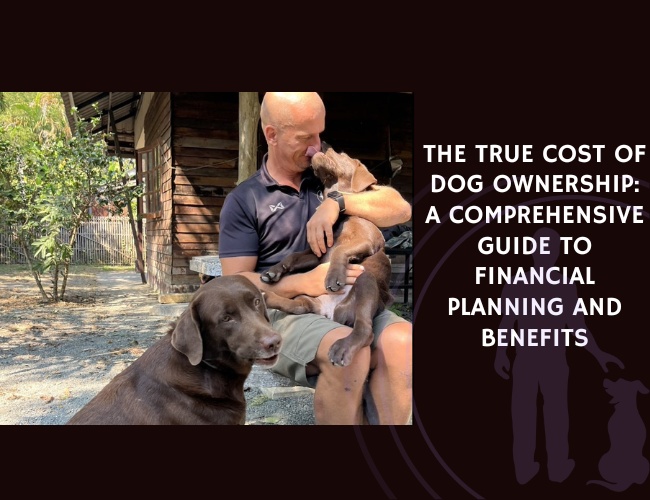Introduction: Understanding the Financial Commitment of Dog Ownership
The Economic Landscape of Having a Dog
Welcoming a dog into your family is more than a heartfelt decision—it’s a financial journey. From adoption fees to daily kibble, there are many economic factors to balance. Initial costs can start with just a modest amount for a rescue pup or climb toward thousands for a purebred from a breeder. Every choice, from food to toys, shapes your dog’s quality of life and your household budget.
Why Financial Planning Is Essential
Taking the time to plan ahead can make all the difference. Before bringing home your furry companion, it’s important to ask yourself if you’re prepared for not just the joyful moments, but also the costs. Expenses can include veterinary care, grooming, training, and even pet insurance premiums. Unexpected bills, such as emergency surgeries or property repairs, may catch you off guard if you’re not ready. Financial planning helps turn surprises into manageable life events, so you can focus on the joy of pet parenthood rather than worry about your wallet.
Weighing Costs Against Benefits
While the costs can seem daunting, it’s helpful to remember the rewards. Dogs can boost your physical activity, improve your mental health, and help you meet new friends. Some studies even suggest owning a dog may reduce overall healthcare expenses by encouraging a more active, social lifestyle. Being organized and realistic with your finances ensures you give your pet the life they deserve—without sacrificing your own security.
Ready to discover what goes into the initial setup and costs for new dog owners? Let’s keep building your roadmap for smart, responsible dog ownership.
Initial Investment: Acquisition Costs and Setup Expenses
Deciding How to Bring Your Dog Home
When it comes to bringing a dog into your life, the first big choice is between adopting from a shelter or buying from a breeder. Adoption fees are usually more budget-friendly, often ranging from $50 to a few hundred dollars depending on the shelter and the dog’s age or breed. In contrast, purchasing a dog from a breeder can be a much steeper investment—sometimes reaching several thousand dollars, especially for rare or sought-after breeds. This up-front cost doesn’t just cover the dog; many ethical breeders include initial vaccinations or microchipping, which can cushion some extra expenses for new owners.
Shopping for Essentials
You’ll also want to prepare your home with some basic equipment. A comfy bed, sturdy leash, collar with ID tag, food and water bowls, and a safe crate are must-haves for most dogs. Many people also invest in a selection of toys to keep their new friend happy and mentally stimulated. Don’t forget cleaning tools for picking up after your pup and keeping their living space tidy!
First Vet Visits and Preventative Care
The first few weeks with your dog will include an introductory visit to the veterinarian. Most vets will check your dog’s overall health, set up a vaccination schedule, and discuss options for preventative care such as flea and tick protection and spaying or neutering. These initial vet bills can quickly add up, especially if your new companion needs deworming or additional tests. Setting aside $200–$500 for these first visits is a safe bet.
Planning for these expenses early on means fewer surprises and a smoother transition for both you and your dog. With a little prep, you set the stage for a happy start together.
Ongoing Expenses: The Monthly and Annual Budget
Dog ownership comes with ongoing expenses that require careful planning. Being prepared for these recurring costs ensures your dog stays happy and healthy, and helps prevent financial surprises down the road.
Veterinary Care
Veterinary bills form a large part of a dog owner’s regular budget. Basic care includes annual check-ups and required vaccinations. Most dogs also require sterilization, which is a one-time, often necessary cost. However, emergency care is unpredictable and can be expensive. While many routine visits are budget-friendly, emergencies and specialty treatments can add significantly to your yearly total. Pet insurance can help buffer these expenses, but comes with its own monthly premiums.
Food and Nutrition
Dog food costs depend on your pet’s size, age, and dietary needs. Small breeds may cost less to feed, while large dogs and those with special diets (like allergens or raw food requirements) increase expenses. Premium kibble is the most affordable option; specialty or raw foods may cost more but can be essential for some dogs’ health.
Training, Grooming, and Recurring Services
Training is often recommended, especially for puppies or dogs that need behavior support. Group classes and private trainers can range from modest to several hundred dollars per year. Grooming costs vary by breed and style—short-haired dogs need less grooming, while long-haired or curly-coated breeds often require regular appointments. Other recurring services, like dog walking, boarding, or pet sitting, add to the monthly total—but can make life much easier for busy owners.
Staying proactive about these ongoing expenses not only ensures your dog’s well-being, but also supports a more stable and enjoyable pet ownership experience.
Hidden and Unexpected Costs of Dog Ownership
Property Damage and Home Maintenance
When a new dog joins your home, a few scratches or chewed corners are often part of the journey. Dogs—especially puppies—love to explore with their mouths and claws. This can mean chewed furniture, gnawed shoes, and scratched floors. Repairs and replacements can quickly add up, sometimes reaching hundreds of dollars. Even well-trained dogs can have accidents, leading to carpet cleaning expenses or the need to replace household items. Expect extra cleaning, increased wear and tear, and tweaks to your living space for both safety and comfort.
Lifestyle Restrictions and Financial Implications
Dogs are loyal companions, but their needs can limit your freedom and flexibility. Spontaneous weekend trips or extended vacations might become less frequent. Boarding, doggy daycare, or pet-sitting services come with additional fees. For some, finding a pet-friendly rental property can mean paying higher deposits or monthly fees. Even daily activities may need adjustments—think about limiting your work hours or skipping outings so your dog isn’t left alone too long. These lifestyle changes can have both direct and indirect financial impacts on your daily life.
Potential Legal and Liability Issues
Dog ownership comes with responsibilities, some with legal costs you might not expect. If your dog causes injury to a person or damages property, you could face liability claims. Local regulations may require licensing, vaccinations, or breed-specific restrictions, sometimes resulting in fines if not followed. Some homeowners or renters insurance policies may exclude certain breeds, leading to extra out-of-pocket costs for extra coverage or exclusion from certain properties.
Dog owners who stay informed and plan ahead are better equipped to handle these hidden costs, ensuring a happy experience for both themselves and their four-legged friends.
Love with Purpose
The journey of dog ownership begins not in the wallet or the heart—but where both align. Real responsibility means understanding that preparation protects you from stress and your dog from uncertainty.
Managing your budget with heart and clarity means fewer surprises and more joy. When you’re prepared, you can fully enjoy the journey with your dog—no matter your income.



A thoughtful start, wise choices, and a bit of creativity can transform dog ownership into something deeply rewarding—for your pet and for the life you’re building together.
Health and Psychological Benefits: The Economic Upside
Reduced Healthcare Expenses and a Healthier Lifestyle
Owning a dog is about more than companionship—it can be a real boost for your health and even your wallet. Studies show that walking a dog gets you moving and encourages regular exercise. This activity can improve cardiovascular health, lower blood pressure, and help maintain a healthy weight. Over time, these benefits may reduce the need for medication and frequent doctor visits, translating into real healthcare savings for many owners. Investing in canine companionship can support a longer, healthier life, while also easing potential medical bills down the road.
Positive Impact on Mental Health
Dogs do wonders for mental well-being. Their presence can ease feelings of loneliness, decrease anxiety, and offer comfort during tough times, such as periods of isolation or crisis. Many people report fewer symptoms of depression and feel a greater sense of purpose thanks to daily routines with their pets. In fact, having a dog may reduce the need for some professional mental health services, which can mean spending less on ongoing therapy or medications.
Social Capital: Stronger Community and Connections
Dogs create opportunities for social interaction and help build community ties. From meeting neighbors at dog parks to chatting with other pet owners on daily walks, dogs have a unique way of breaking the ice. These social connections can offer emotional support and foster a sense of belonging, both of which are priceless for personal happiness and well-being. Community involvement has tangible value, sometimes leading to better access to resources and a stronger support network.
Understanding the broader impact of dogs—beyond personal finances—helps paint a fuller picture of their value in our lives.
Service Dogs: Special Economic Considerations
The cost and value of service and assistance dogs
Service and assistance dogs bring life-changing independence and security to many individuals. The upfront investment in a service dog can vary widely. Training a dog for specialized work, like mobility or seizure response, often costs tens of thousands of dollars. However, this significant expense is often offset by reduced reliance on human caregivers, lower healthcare costs, and improved daily functioning.
When compared with alternative assistive measures, service dogs offer unique, ongoing personal support that devices or paid help may not match. For example, instead of hiring full-time assistance or investing in expensive medical devices, a trained dog can perform essential tasks such as retrieving items, alerting to medical issues, or providing emotional comfort. These dogs often help reduce hospitalization or therapy visits, offering genuine financial savings over time[The Economics of Dog Ownership Exam.txt].
Funding and support for service dogs
Acquiring a service dog is a substantial commitment, but there are ways to ease the financial burden:
- Nonprofit grants: Some organizations provide grants or reduce costs for qualifying individuals.
- Crowdfunding: Families often fundraise through online platforms to meet costs.
- Insurance support: While not universal, some insurance plans partially cover costs related to service dog care or training.
Many service dog organizations strive to offer sliding scales or payment plans, making access more equitable for people of varying financial backgrounds.
Greater impact beyond the user
The benefits of service dogs are not only personal. Empowered individuals often require fewer expensive interventions or medical services, creating systemic savings. They participate in work and community life more fully, increasing productivity and reducing reliance on social programs. This positive ripple effect highlights the far-reaching value of investing in service and assistance dogs.
Moving forward, it is essential to consider the broader impact these remarkable dogs have on our communities and public systems.

The Broader Economic Impact: Dogs in Society
Public Investment and Animal Welfare
Dog ownership isn’t just a private financial commitment—it also shapes policy and society. Governments spend significant budgets on animal welfare, shelters, and control programs each year. Funds go towards building and maintaining shelters, staff salaries, food, medical care, and community outreach to manage stray and abandoned dogs. These expenses are not only necessary for animal welfare but also help in preventing overpopulation and addressing public health concerns related to unowned animals.
Dogs and Urban Planning
Dogs influence where and how we live. Demand for pet-friendly housing has driven landlords and real estate developers to adapt rental policies, allowing more pets and installing amenities like dog runs or pet washing stations. Urban planning now includes designated dog parks and green spaces, helping boost local property values and creating opportunities for community gathering. On the flip side, there are still rules and limits—such as breed restrictions or higher pet deposits—that can affect both renters and those selling their homes.
Economic Value of Working Dogs
The economic contribution of working dogs is profound. In public safety, law enforcement relies on dogs for search-and-rescue, narcotics detection, and crowd control. These dogs perform tasks that would otherwise require much higher human labor costs, directly improving public safety and operational efficiency. Beyond policing, dogs are vital in fields like agriculture (herding and guarding livestock), customs control, and even in therapy roles in hospitals and schools.
As we move forward, it’s important to recognize that the presence of dogs not only affects individual households but shapes entire sectors of our economy and daily life, creating both opportunities and new challenges.
Cost-Saving Strategies for Dog Owners
DIY Care and Homemade Nutrition
Caring for your dog on a budget doesn’t mean cutting corners on their health or happiness. Many owners have found that preparing homemade dog food or treats, when done carefully, can be both rewarding and affordable. By using simple ingredients like brown rice, lean meats, and vegetables, you can create balanced meals at home. However, always check with a veterinarian to ensure the recipes meet your dog’s nutritional needs. Grooming at home—like regular brushing and bathing—can also save on professional costs and deepen your bond with your dog.
Adoption and Choosing Wisely
Adoption campaigns are a fantastic way to save money and provide loving homes to dogs in need. Adoption fees are typically much lower than the high prices charged by breeders, especially for popular or rare breeds. Adopting from shelters or rescue organizations can also mean your dog comes vaccinated and spayed or neutered, reducing your initial expenses. Looking beyond purebreds to mixed-breed dogs can open up even more affordable options and enrich your family with a pet just as loving.
Secondhand and Shared Markets
Before shopping for brand-new supplies, check out local buy-sell-trade groups, online marketplaces, or rehoming apps for gently-used pet items. Items like crates, bowls, and toys often have a long life and can cost a fraction of retail price when purchased secondhand. Hosting “pet supply swaps” with fellow dog owners can be another creative way to get what you need without breaking the bank.
Being resourceful not only eases your monthly budget but can also reinforce the joy of pet ownership. With thoughtful planning and smart choices, you can provide your dog with a wonderful life—no matter your financial situation.
Economic Trends in the Pet Industry
Canine Sector Growth and Innovation
The dog care market is booming, offering more choices than ever for pet owners. With more households welcoming dogs, businesses are responding with innovative solutions. Key growth areas include pet technology, organic food, and pet insurance. Smart collars, activity trackers, and health monitoring apps are becoming essential for dog parents seeking peace of mind. At the same time, organic and specialty foods are on the rise, as owners focus on their dogs’ wellness and unique diets.
Pet insurance is also rapidly gaining popularity, helping families handle unexpected vet bills. While premiums add to the overall cost, they offer confidence against expensive emergencies and ongoing care needs.
Emerging Consumer Trends
The rise of subscription boxes has changed the way owners shop for treats and toys. Monthly deliveries of curated goodies delight both pets and people, offering convenience and surprises. Likewise, mobile dog grooming and training services are expanding, making it easier to keep dogs healthy and well-behaved without the hassle of travel.
E-commerce now plays a huge role, giving dog owners access to global brands and niche products with the click of a button. This shift fuels competition and drives more personalized services and products.
The Power of Social Influence
Social media has transformed how we find and buy dog-related products. Dog influencers—adorable pups with huge online followings—often shape popular trends. Their product endorsements and reviews can lead to spikes in sales and even help new brands succeed. For companies, appealing to dog lovers on social platforms is a smart way to build trust and reach a bigger audience.
As the industry evolves, these trends create both exciting opportunities and new considerations for dog owners.
Economic Factors Affecting Dog Abandonment
How Economic Shifts Shape Pet Relinquishment
Economic conditions have a deep impact on dog ownership. Inflation and economic downturns make it harder for owners to afford care, leading some to face the difficult choice of surrendering their pets. When living costs rise—like housing, food, or vet care—families with tight budgets often struggle first, leading to increased rates of abandonment and rehoming. During tough financial times, shelters see more dogs surrendered because owners simply can’t manage the added expense.
Support Systems for Owners in Crisis
To help prevent heartbreaking decisions, communities and organizations have created support systems for struggling pet owners. These include:
- Local food pantries that supply pet foods
- Low-cost or free veterinary clinics for basic care
- Subsidized spay/neuter services
- Temporary foster care programs for families in crisis
Some cities even team up with animal welfare groups to offer vouchers or financial aid so families can keep their pets during short-term hardships. With help, owners get breathing room to recover without giving up their beloved dogs.
The Bigger Picture: Economic Impact of Abandonment
Dog abandonment has a ripple effect. It drives up public spending on animal control, shelter care, and rehoming efforts. Shelters face higher costs for food, medical care, staffing, and facilities every time surrenders spike. In turn, communities may budget more to support these needs, with animal welfare becoming a larger public policy issue.
Empathy and practical resources go a long way in keeping pets and families together, especially when money gets tight. These efforts not only support individual dog owners but also lessen the strain on shelters and communities.
Transitioning from understanding the causes and impact of dog abandonment, it’s important to plan ahead for your dog’s financial future and stability.
Long-Term Financial Planning for Dog Owners
Building a Lifetime Budget
Planning for your dog’s entire life helps prevent financial surprises. Start by estimating all the key expenses from puppy to senior years. List recurring costs like food, annual check-ups, vaccinations, and training sessions. Factor in equipment replacements—beds, leashes, and toys need updating over time.
It’s wise to include costs that grow as your dog ages. For example, as dogs move into their golden years, they may need more frequent vet visits or specialized diets. These small expenses pile up, making it crucial to keep a detailed, flexible budget.
Preparing for Senior Dog Care
As your dog ages, veterinary needs change. Older dogs might need special food, joint supplements, regular blood work, or even prescription medications. Mobility aids, ramps, or orthopedic beds can also become necessary. Set aside funds early, so when these senior expenses arrive, you can focus on their comfort instead of the cost.
Emergency Funds and Insurance
Emergencies are unpredictable. Broken bones, sudden illness, or accidental injuries can mean vet bills in the hundreds—or even thousands—of dollars. Creating an emergency fund just for your dog is a smart safety net.
Additionally, consider pet insurance (PI) to help cover costly treatments. Research different plans and choose one that fits both your dog’s needs and your budget. While premiums add to yearly costs, they can mean relief from financial stress during critical moments.
Thoughtful planning—through budgeting, prepping for senior care, and safeguarding with insurance and savings—means you’ll be ready for every step in your dog’s journey. This support ensures your pup gets the best life possible, no matter what surprises come your way.
Conclusion: Balancing the Economics of Dog Ownership
Reflecting on Financial Commitment
Owning a dog is both a joy and a responsibility. The journey begins with upfront costs, like adoption or breeder fees and supplies. These expenses continue every month, including food, veterinary visits, training, grooming, insurance, and even dog walking or pet-sitting when life gets busy. But there’s more to it—hidden costs, such as property repairs or unexpected vet emergencies, can catch anyone off guard. Taking time to create a budget before bringing a dog home helps you avoid surprises.
Weighing the Benefits Against the Costs
The financial commitment is significant, but let’s not forget the value dogs add to our lives. Scientific studies show dogs help boost physical health through daily exercise and reduce loneliness and anxiety, which can mean fewer trips to the doctor and less spent on healthcare over time. Plus, the social connections made at dog parks or in your neighborhood can foster community and support networks. For some, service dogs provide vital assistance that can replace pricier technologies or care services, further tipping the scale toward the benefits of having a dog in your life.
Resources to Manage Costs
There are plenty of resources available for those ready to manage the costs effectively. Look for local animal shelters, rehoming platforms, and adoption campaigns to save on initial costs. Many communities have low-cost veterinary clinics and pet food banks for when times get tough. DIY care tips, shopping for secondhand supplies, and comparing pet insurance plans can help you save even more. Remember, financial planning and creativity go a long way to ensuring your dog lives a happy, healthy life—no matter your budget. 🐾



